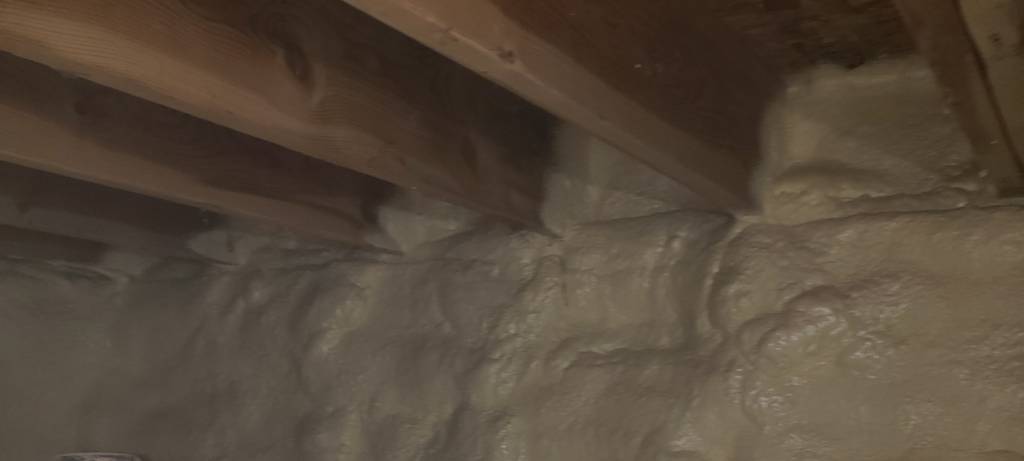Why Spray Foam Insulation is Best for Crawlspaces

A study by the Survey of Construction reported that of the foundation of homes built in 2021, only 11% were built on a crawlspace. This number has decreased with 14.5% being built on a crawlspace in 2016, which also declined from previous years. While crawlspaces have become less popular for new homes, many previously built homes do have them, and they can be a big source of an uncomfortable home.
A crawlspace is a common entry point for unwanted cold or hot air depending on Michigan’s season. As this air continues to enter the home, it can lead to uncomfortable and uneven temperatures throughout your home. One of the most common fixes for this issue is to insulate your crawlspace with spray foam insulation. In this article, we will explain why spray foam insulation is the best choice for crawlspace insulation.
Reasons to use spray foam insulation in a crawlspace
Spray foam insulation has become a go-to for insulation for new homes. It is also beneficial for a crawlspace, both new and old. Here are some of the most common reasons why spray foam insulation is best for crawlspaces.
Spray foam insulation is a temperature barrier
Spray foam insulation will create a temperature barrier for your crawlspace which is often one of the coldest or most humid areas of a home. The temperature barrier helps to create a comfortable home by keeping unwanted air from traveling to different areas of your home. Encapsulating your crawl space with closed cell spray foam can also prevent a cold floor above, making your home more comfortable.
Spray foam insulation reaches nooks and crannies
Spray foam insulation is ideal for crawlspaces due to its ability to get into the smallest places. This can help prevent any cool or warm air from sneaking into your home through small areas in your crawlspace.
Improves air quality
With spray foam insulation blocking external airflow, it can help improve your home’s indoor air quality. The spray foam insulation helps to block pollen and other unwanted pollutants from entering your home. Preventing these pollutants can also cut down on dust in your home, thus improving indoor air quality.
Prevent mold and mildew from growing
Closed cell spray foam insulation resists moisture which can be common in crawlspaces. Moisture in crawlspaces can easily turn into mold and mildew in a dark environment. Encapsulating your crawl space with closed cell spray foam prevents water from entering your crawlspace to help avoid mold and mildew.
Creates a smell barrier
Crawlspaces often get a bad rap for having a distinct wet smell. Installing a vapor barrier on the ground of the crawlspace and insulating the walls of the crawlspace to seal up to the vapor barrier will eliminate the path for the small to communicate up into your home. Insulating with closed cell spray foam helps to create a smell barrier preventing the smell from escaping the crawlspace and traveling to other rooms in your home.
Helps keep pests away
Pests and small rodents are less likely to be able to get into spray foam insulation, unlike other forms of insulation. With spray foam insulation effectively covering all the small holes and gaps in a crawlspace, it is difficult for pests and rodents to enter your crawlspace as well.
Should I insulate the walls or ceiling of my crawlspace?
The answer to this question is, it depends. Depending on where ductwork or plumbing is located in the crawlspace, will determine if the walls or ceiling of a crawlspace should be insulated. If there is ductwork or plumbing in the crawl space, then the exterior walls would be insulated. If there is no ductwork or plumbing on the ceiling, then spray foam could be installed here. However, most clients like to encapsulate their crawlspaces by insulating the walls of the crawlspace and sealing the ground with a vapor barrier, to utilize the crawlspace for storage. Encapsulating the crawlspace effectively turns your crawlspace into a mini basement so it helps to keep the floors above from getting cold during the winter months.
What is the process for insulating my crawlspace?
To insulate a crawlspace, old insulation must first be removed. If necessary, any mold or mildew will also be cleaned up before new insulation can be installed. A thick vapor barrier is installed on the ground of the crawlspace to prevent moisture in the form of vapor from getting into your home. The last step is installing closed cell spray foam insulation on the walls and rim joist of your crawlspace.
Contact Ecotelligent Homes for crawlspace insulation
Are you ready to insulate your crawlspace with spray foam insulation? Contact Ecotelligent Homes to complete an energy audit to find out if spray foam insulation in your crawlspace will improve your home’s comfort.

Ecotelligent Homes
Since 2009, more than 3,000 Michigan homeowners have trusted Ecotelligent Homes to make their homes comfortable and efficient. If you want an energy audit, insulation, HVAC, or abatement services, give us a call anytime: (248) 291-7815. Satisfaction guaranteed.
